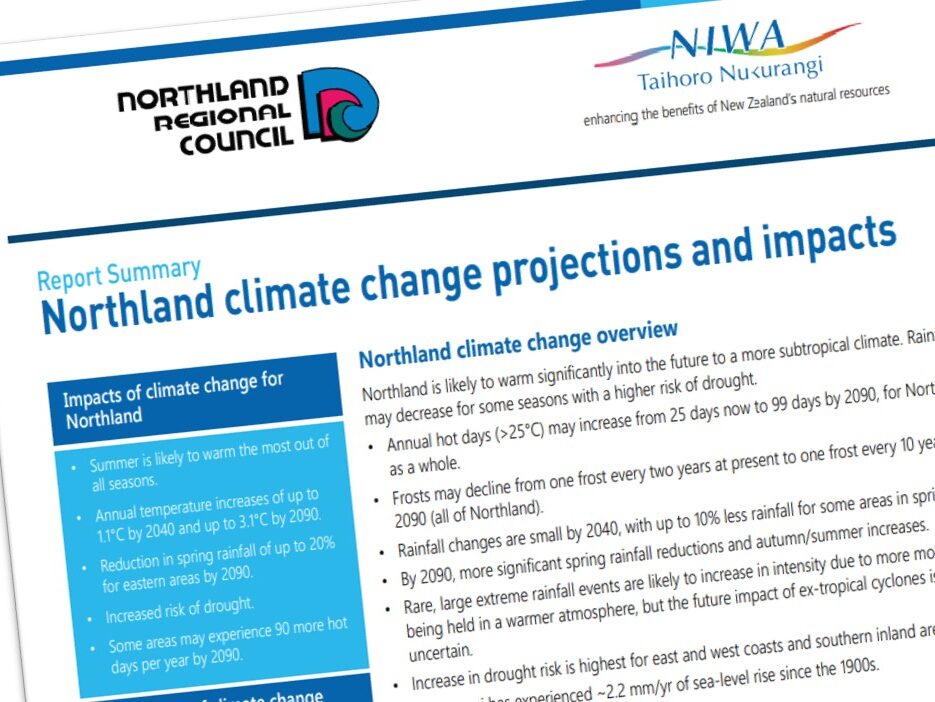
5 August 2024
What Is Our Risk? How Climate Change Impacts Us
Northland Regional Council commissioned a 2016 report from the National Institute of Water and Atmospheric Research (NIWA) on climate change projections for Te Taitokerau. This report tells us how climate change might impact our region by 2040 and 2090.
It highlights:
“Northland is likely to warm significantly into the future to a more subtropical climate. Rainfall may decrease for some seasons with a higher risk of drought.
- Annual hot days (>25°C) may increase from 25 days now to 99 days by 2090, for Northland as a whole.
- Frosts may decline from one frost every two years at present to one frost every 10 years by 2090 (all of Northland).
- Rainfall changes are small by 2040, with up to 10% less rainfall for some areas in spring.
- By 2090, more significant spring rainfall reductions and autumn/summer increases.
- Rare, large extreme rainfall events are likely to increase in intensity due to more moisture being held in a warmer atmosphere, but the future impact of ex-tropical cyclones is uncertain.
- Increase in drought risk is highest for east and west coasts and southern inland areas.
- Whangarei has experienced ~2.2 mm/yr of sea-level rise since the 1900s.”
The report is available from the Northland Regional Council website:
Climate Change Projects and Implications for Northland (PDF, 4.9MB)
Expanding on this report, councils in Te Taitokerau reviewed climate change impacts and developed a risk overview for the region. It identifies how the range of climate change impacts identified above might impact the region’s ecology, people, social values, Māori cultural values, physical infrastructure and economy.
The risk overview shows how climate change may impact many of the aspects of life in Te Taitokerau by using impact diagrams for key climate change hazards:
- Mean temperature increase and heatwaves (page 9)
- Changing seasons (page10)
- Drought and mean rainfall decline (page11)
- Wildfire (page 12)
- Extreme rainfall and storms (page13)
- Coastal flooding and erosion (page 14)
- Permanent tidal inundation due to sea level rise (page 15)
- Marine impacts (page 16)
The risk overview explores possible implications for each case for life in Te Taitokerau. It’s important to note the overview does not attempt to identify the extent of the impact in each case, so it does not prioritise risks or look at how we could manage them.
Te Taitokerau Climate Adaptation Strategy: Appendix Two: Climate risk overview
Te Taitokerau Climate Adaptation Strategy
The result of this overview was the development of the Te Taitokerau Climate Adaptation Strategy. The strategy details the needs of the region in responding to the threats and opportunities of climate change, and in particular the long-term needs to invest in community adaptation to climate change.
New Zealand’s government declared a climate emergency on 2 December 2020 and holds the lead responsibility for Aotearoa New Zealand’s transition to a low-emissions society and economy. Local government has a supporting role in this climate change mitigation mahi, to assist and enable the required transitions in districts and regions.
Climate change adaptation, however, must be led by councils, iwi, hapū, industry stakeholders and the wider community. This strategy represents a first step by Northland councils towards a collaborative, region-wide response to the impacts of climate change. We are already living with the effects of a changing climate, and many communities in Te Taitokerau have been using their own resources and networks to develop plans to prepare and adapt. Through this strategy, Northland councils and tāngata whenua are building on these plans, seeking integration and alignment across the region, and working to create meaningful partnerships to help us all adapt together.
The priority actions identified in the strategy are the basis of councils’ collective investment into climate action today. They are presented as seven broad themes:
- Governance and management
- Impacts on Māori
- Coastal communities
- Water availability
- Natural hazards
- Ecosystems and biosecurity
- Public infrastructure.
You can find more information, and read the strategy in full, at the link below.
Posted in: Education